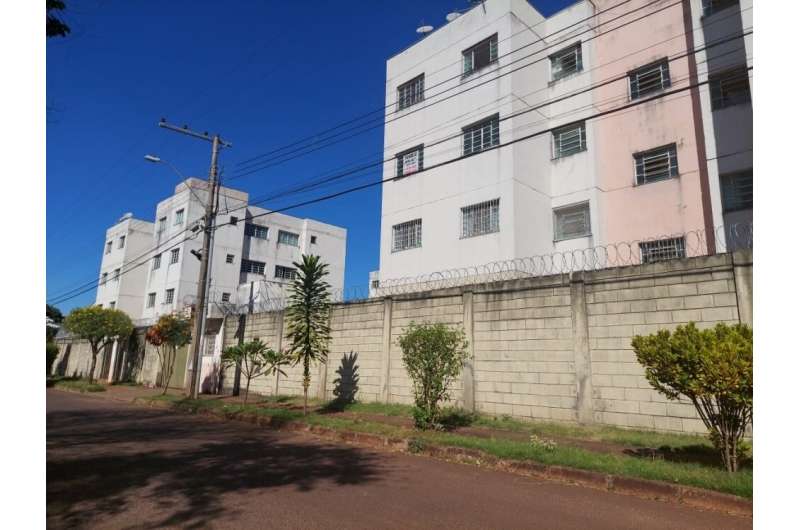This article has been reviewed according to Science X's editorial process and policies. Editors have highlighted the following attributes while ensuring the content's credibility:
fact-checked
trusted source
proofread
Study proposes simple low-cost solutions to improve thermal comfort in social housing

Brazil has a housing deficit of 5.876 million units (5.044 million in urban areas and 832,000 in rural areas), according to the latest government survey.
The number corresponds to 8.1% of the nation's total stock of private dwellings, permanent and improvised. To make good at least part of this huge social debt, the federal government launched a low-income housing program called Minha Casa Minha Vida ("My Home My Life") in 2009.
However, funding was insufficient to meet demand of this size, and low investment allocated to construction of each unit resulted in problems such as lack of thermal comfort, a constant complaint by residents.
To develop simple and low-cost solutions to the problem, a pilot study was conducted at Residencial Baltimore, a social housing project in Uberlândia, Minas Gerais state, by researchers affiliated with the Federal University of the Minas Triangle's Institute of Technological and Exact Sciences (ICTE-UFTM) and the University of São Paulo's Institute of Energy and Environment (IEE-USP), also in Brazil. The study was led by Dominique Mouette, a professor at USP's School of Arts, Sciences and Humanities (EACH).
An article on the study is published in the journal Sustainability.
"The best design in terms of thermal comfort combined three simple, cheap and sustainable solutions: replacing conventional windows with fully openable tilting windows; replacing brick walls with monolithic expanded polystyrene walls; and replacing ordinary window glass with green-tinted tempered glass," said Vitória Elisa da Silva, second author of the article and a researcher at ICTE-UFTM.
Residents frequently complain that the houses are hot and stuffy, she explained. The usual windows in these projects can only be half-opened. Tilting windows can be fully opened, substantially boosting airflow and natural ventilation. The use of expanded polystyrene in the walls and green-tinted glass in the windows contribute to insulation, blocking part of the thermal energy received from the environment.
The walls are made of sheets of expanded polystyrene (EPS) coated with stucco (cement plaster). EPS is inexpensive, lightweight, resistant to water and moisture, and widely used for thermal and acoustic insulation.
Its thermal conductivity is very low compared with conventional wall materials such as hollow bricks or concrete blocks so that less heat is conveyed from the outside to the inside of the wall. The main drawback is that it is a petroleum product and hence non-biodegradable. When dumped in a landfill, it takes at least 500 years to decompose. However, as the article notes, it can be effectively recycled, and this reduces its carbon footprint.
Energy saving
According to Mouette, enhancing thermal comfort was a major motivation for the study, but it was part of a much broader research effort. "The study can be considered a contribution to the search for energy-saving alternatives that reduce global carbon emissions. In many cases, air conditioners account for at least half the electricity consumed by a home or office. We set out to develop a cooling solution that could be cheaper and have less environmental impact," she said.
Besides guzzling electricity, air conditioners are a source of environmental warming. They expel warm air, creating islands of heat above and around tall buildings and entire city blocks. "The result is a vicious circle because external warming induces extra use of air conditioners, and all this has a huge environmental impact that can only aggravate the climate crisis," Mouette warned.
The association between thermal comfort and air conditioning is questionable, she added, because this kind of artificial indoor cooling can actually be uncomfortable, not to mention unhealthy.
Cylon Liaw, first author of the article and a researcher at IEE-USP, highlighted the social aspect of the problem. "The units built by the program are all the same, whatever the climate where projects are located. The solutions we proposed for Residencial Baltimore in Uberlândia also took into account the financial situation of the families involved, who can't afford air conditioning or the huge electricity bills it entails," he said.
As for whether the proposals will be implemented, Liaw noted that when the government relaunched the program in February 2023, it stated its readiness to listen to residents' complaints. "I don't know if that includes the issue of thermal comfort, but I do think our study represents at least a step in the right direction," he said.
Minha Casa Minha Vida was shut down in 2020 and replaced by an entirely different social housing program called Casa Verde e Amarela. "The amount allocated to the program was drastically reduced on a per-unit basis, and we had to adjust our own cost estimate when we conducted our study in 2021 and 2022," Law said, adding that another co-author, Rebecca Maduro, an architect and also a researcher at IEE-USP, made a most important contribution in this regard. "She participated in the program for more than two decades. Her input was fundamental."
To develop their solutions, the researchers constructed a model based on the standard unit's living room, with an area of just under 11 square meters and a ceiling height of 2 meters, and with multiple interacting variables, such as airflow, heat transfer, temperature and humidity, all integrated and quantified using systems dynamics and computational treatment.
"The next step entailed setting values for entry variables such as useful ventilation area or glazing and wall materials and then simulating the different resulting scenarios. From the worst to the best scenario, the peak temperature was substantially lower for larger window openings, demonstrating that natural ventilation and simple, widely available building elements contribute to thermal comfort in the home," Silva said.
More information: Cylon Liaw et al, Thermal Comfort Analysis Using System Dynamics Modeling—A Sustainable Scenario Proposition for Low-Income Housing in Brazil, Sustainability (2023). DOI: 10.3390/su15075831

















